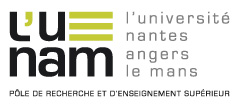Dietary source of selenium in nulliparous sows: the importance of vitamin B6 for some aspects of antioxydant status and ovulation during the peri-estrus period
Résumé
In this experiment, it was hypothesized that there is an interaction between pyridoxine (B6) and selenium (Se) metabolisms for an adequate flow of organic Se (Se-cysteine) toward the glutathione peroxidase (GPX) system in response to oxidative pressure induced by the peri-estrus period in sows. Forty-five gilts received one of the 5 dietary treatments (n = 9/group): 1) basal diet (Se = 0.2 mg/kg and B6 = 2.5 mg/kg) (C); 2) # 1 + 0.3 mg/kg Na-Se (MSe0B6); 3) # 2 + 10 mg/kg B6 (MSe10B6); 4) # 1 + 0.3 mg/kg Se-yeast (OSe0B6) and 5) # 4 + 10 mg/ kg B6(OSe10B6). Treatments started at first pubertal estrus and lasted up to 3 d after fourth estrus. Blood was collected from all gilts at each estrus. At slaughter, liver and kidneys were collected and corpora lutea were counted. At fourth estrus, blood Se was lower in C vs Se gilts and higher in OSe’s vs MSe’s (229.0, 251.2, 250.7, 288.9 and 282.6 μg/L in groups 1, 2, 3, 4 and 5, respectively, SE = 7.3)(P < 0.01) while blood GPX activity was higher in MSe vs OSe gilts and both were higher vs C’s (117.6, 148.3, 145.6, 125.6 and 131.9 mU/mg hemoglobin in groups 1, 2, 3, 4 and 5, respectively, SE = 6.4)(P < 0.01). In spite of Se effects (as in blood, P < 0.01) on Se in liver (0.7, 0.8, 0.7, 1.0 and 1.0 μg/g in groups 1, 2, 3, 4 and 5, respectively, SE = 0.1) and kidneys (2.5, 2.5, 2.4, 2.7 and 2.7 μg/g in groups 1, 2, 3, 4 and 5, respectively, SE = 0.1), there was no treatment effect (P > 0.50) on GPX activity in these tissues. However, gene expressions of cytosol GPX (GPX1) and Se-cysteine oxidase (control of the flow of Se-cysteine to the GSH-Px system) in both liver and kidneys were 50 to 70% higher in OSe10B6 gilts than in others (interaction Se x B6, P < 0.01). Ovulation rate were 17.4, 16.7, 17.7, 16.9 and 21.2 (SE = 0.9) in groups 1, 2, 3, 4 and 5, respectively (B6 effect P < 0.01, Se effect P < 0.06 and interaction B6 x Se, P < 0.09). In conclusion, dietary B6 is a modulating factor of the metabolic pathway of organic Se toward the GPX system and may be involved in ovarian function leading to optimal ovulation conditions.
Domaines
Science des productions animales
Origine : Fichiers éditeurs autorisés sur une archive ouverte

